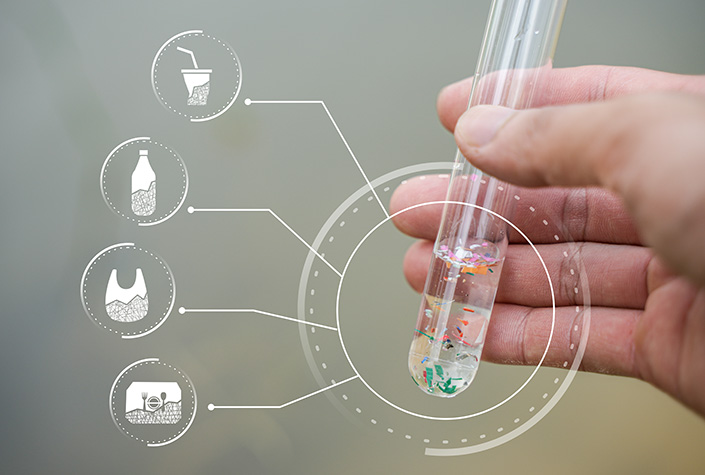Removing microplastics and nanoplastics from aquatic environments

Credit: Naiyana Somchitkaeo/shutterstock.com
A new study led by Texas A&M AgriLife Research has identified what may be a novel biological approach for removing extremely small and potentially dangerous plastic particles from water.
The study, called “Microplastics removal in the aquatic environment via fungal pelletization,” was headed by Dr. Huaimin Wang a post-doctoral scientist in the Texas A&M College of Agriculture and Life Sciences Department of Plant Pathology and Microbiology. Collaborators included Dr. Susie Dai, an associate professor in the department, and a team of researchers.
The U.S. Department of Agriculture Forest Service’s Northern Research Station also participated in the study, which can be found online in the September edition of Bioresource Technology Reports.
“Although fungal pelletization has been studied for algae harvesting and wastewater treatment in the past decade, to the best of our knowledge, it has not yet been applied for the removal of microplastics from an aqueous environment,” Dai said. “This study examines their use for that purpose.”
Microplastics, tiny plastic particles resulting from commercial product development and the breakdown of larger plastics, have gained increasing attention in recent years due to their potential harm to the ecosystem. With the continual increase of global plastic production, pollution from this persistent waste contaminant group derived from synthetic polymers presents a significant environmental challenge.
While the health risks posed by submicrometer microplastics to humans are not yet fully understood, those studying them generally believe the overall risk associated with submicrometer microplastics – those less than a micron in a specified measurement — is higher than that of larger plastics. They hypothesize this is due in large measure to their greater potential for long-range transport and ability to more easily penetrate the cells of living organisms.
“Previous studies have indicated that submicrometer microplastics can easily travel considerable distances in the environment, infiltrating plant root cell walls,” Wang said. “They have even been shown to have been transported into plant fruiting bodies and human placenta.”
Besides microplastics generated from direct human activity such as cosmetic and industrial production, nanoplastics — synthetic polymer particulates ranging from 1 nanometer to 1 micrometer in diameter — can also be generated from the fragmentation or degradation of larger plastics.
A significant portion of microplastics generated from human activities end up in sewage and wastewater treatment plants. While these plants can remove the vast majority of them, many of the submicrometer particles are unfiltered.
“The microplastics and nanoplastics removed after activated sludge treatment can be further removed by additional conventional methods such as coagulation, disk filters and membrane filtration,” Dai said. “But enriched microplastics still pose a waste-management challenge.”
Unfortunately, she said, some disposal methods like landfill interment or incineration are not environmentally favorable for reintroducing these back into the natural carbon cycle.
For the study, three fungal strain candidates were chosen based on their speed of growth, dye degradation, spore production and pellet formation. Two were newly isolated white rot fungi strains.
The study yielded encouraging findings on removing polystyrene and polymethyl methacrylate microplastics and nanoplastics — ranging from 200 nanometers to 5 micrometers in the aquatic environment — using these isolated fungal strains.
“These types of microplastics and nanoplastics are among the most common,” Dai said.
The three strains showed a high rate of microplastic removal and exhibited potential microplastic assimilation.
“The microplastics attach to the surface of the fungal biomass, which makes it easier to remove them from water as part of the pellet,” Dai explained.
Wang said due to the unique capacity of the selected white rot fungal strains to form pellets, they should be suitable for remediating microplastics.
“They may also have the potential for use in upgrading wastewater treatment plants and as a cost-effective means to further remove microplastics and minimize the pollution by plastics in natural water bodies,” he said.

